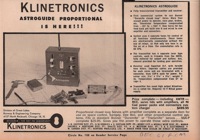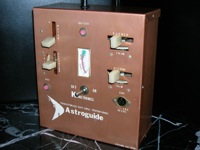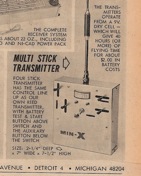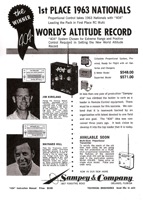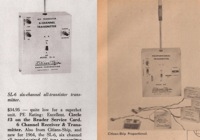Special Exhibit:
Citizen-Ship 4 Stick
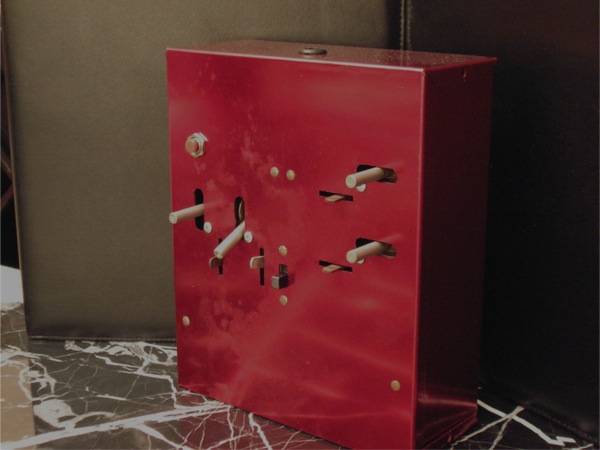
(Click on any of the images on this page to see a larger version)
This is Citizen-Ship’s 4 stick digital proportional. It is autographed by Ed Hughey, long time Citizen-Ship engineer and executive. Yes, he’s the same Ed Hughey famous for Hughey Boats and his world record RC hydroplanes.
This was the prototype for a line of 4 stick proportional systems Citizen-Ship ultimately decided not to produce. It may also be Citizen-Ship’s first digital radio as explained below.
In the initial years of proportional, many manufacturers considered producing 4 stick models in addition to the customary 1 and 2 stick versions. The logic driving 4 stick systems was that they could be made to closely resemble the dominant reed sets and tap a new market of entrenched reed flyers who could be lured to proportional with a transitional transmitter having controls in all the familiar places.
Thus, 4 stick transmitters have rudder and aileron sticks on the upper right hand side, moving left and right only, and elevator and motor sticks on the left hand side, moving up and down only. This enabled reed flyers’ thumbs to operate the same function at the same location on the transmitter, only with full sliding proportional control instead of “bang-bang” flipper switches. Citizen-Ship’s famous owner Vernon MacNabb revealed his thinking on this in the Jan/Feb 64 Grid Leaks when Citizen-Ship was striving to produce its first proportional. He said “…if it were not for the habit-conditioned reed flyers, ailerons and elevators should be on one stick…”
Other 4 Stick Proportionals
We are aware of only one manufacturer that actually produced 4 stick proportionals – Klinetronics. Here is an ad for the system, the “Astroguide” and photos of an actual Astroguide system:
Although nationally advertised we believe very few Astroguides were ever produced. It is likely that Klinetroincs’ failure to generate the expected sales to reed flyers was a major factor in the decision of other manufacturers’ to abandon their 4 stick programs at the prototype or drawing phase.
Here is a photo of the Min-X 4 stick system. Min-X went so far as to assemble an attractive, full-finish prototype and display it at a trade show. None were ever produced.
Here is an advertisement offering a 4 stick Sampey 404. As far as we know, the 4 stick Sampey never went further than this drawing.
In the Jul/Aug 63 A.M. it was reported that F&M was also working on an “experimental” 4 stick proportional. The editors recognized that this could make it easier for reed flyers to transition to proportional, but wondered whether it could be “true proportional” since the 4 sticks “would have to be thumbed like reed levers”.
Oddities
The first mystery about Citizen-Ship’s 4 stick is that the elevator and throttle controls are side by side. Reed sets including Citizen-Ship reeds, had motor and elevator controls above and below each other. Ten and twelve channel rigs would have an elevator trim lever side by side with the elevator control, but not motor control.
The larger mystery is the timeline. No one recalls when this prototype was made. Other known programs to produce 4 channel proportionals date to the early analog days. This transmitter is digital.
One big clue is Citizen-Ship’s SL-6 reed transmitter which was introduced just 8 months prior to its first production proportional, the APT. Compare these product announcement pictures for the two products (Mar 64 RCM and Jan-Feb 65 GL):
The resemblance is so striking as to defy co-incidence. It appears Citizen-Ship’s first proportional system, commercially produced in large numbers, was itself a reed transitional hybrid or mini-version of the 4 stick reed-imitating proportional. Notice how the motor control is in the same position and uses the same reed-type switch with the same labeling, the rudder control is in the same position on the right with the same labeling and the elevator control is in the same position on the left with the same labeling. Other 2-3 channel proportionals combined rudder/aileron and elevator on a single stick. To top it all off, the cases used for the APT proportional transmitter and the SL-6 reed transmitter are the same.
Citizen-Ship’s first digital system was not announced until June 1966. By then, stick modes were well established in the industry and there should have been no further consideration of 4 stick reed imitations. So how can this transmitter be explained? One possibility is that it was made much earlier. It has the same sticks as Citizen-Ship’s first production proportional, the analog “APT”. By the time Citizen-Ship announced the APT in January, 1965, digital systems were on the ascendancy and said by RCM and others to be the future of radio control.
Vernon MacNabb and his engineers were so competent and attuned to industry trends that they could well have been working on a digital system at the time their first analog was introduced, or even earlier. If so, this transmitter may have been Citizen-Ship’s first digital proportional and would naturally have used the same stick, gimbals, pots and reedlike control layout as their first production proportional.
This could also explain why the 4 stick proportional is housed in a Citizen-Ship 10 channel TMS reed case instead of the smaller cases used for the various Citizen-Ship proportional transmitters (the APT cases being smaller that the DPT, but all being smaller than this prototype). In addition, the sticks are about 1/8” shorter than APT sticks. This may have been a deliberate shortening of APT sticks to make them more “reed-like”, or it may indicate this prototype was built before the APTs (i.e. before Citizen-Ship had supplies of APT sticks and other parts to use on this prototype). Moreover, while this prototype uses the earlier APT type sticks, gimbals and pots (not those seen on later Citizen-Ship digital sets) two gimbal components (the pot collar and spring stop) which look identical to their counterparts on the APT are made of raw steel not silver (cadmium?) plated steel as found on even the first production APTs. This seems to indicate that it preceded the first Citizen-Ship analog proportional.
Similarly the “L” shaped spring engager on each prototype gimbal looks the same as those on APT gimbals but is actually 1/16” shorter with a different indentation opposite its curve. If the 4 stick was made after the APT was in production why wouldn’t its builder simply take standard APT parts out of the bin, instead of custom machining nearly identical parts with differences serving no functional purpose?
It is easier to understand this if you imagine the prototype 4 stick was produced before the APT and the availability of APT parts. Its gimbals would then have been the model which was closely (but not exactly) copied for the APT.
Another mystery is whether our 4 stick is actually analog or digital. Two Citizen-Ship engineers at first proclaimed it digital then had their doubts. To help resolve all these issues we sent a set of internal and external pictures to Ed Rutherford. Rutherford is recognized as one of the preeminent experts in the world on vintage RC radios. After examining the pictures Ed advised that this prototype is a digital and probably predates Citizen-Ship’s APT. He noted it may be a tone digital – a hybrid concept attempted by other manufacturers without success. Research continues.




